Mole Removal Treatment
Effective Mole Removal Treatment in Montreal with Cryoprobe Pen | Reimagine Clinic
Looking for a mole removal treatment in Montreal? Discover the advanced and safe cryotherapy procedures at Reimagine Clinic. Let us help you regain your skin's natural beauty.
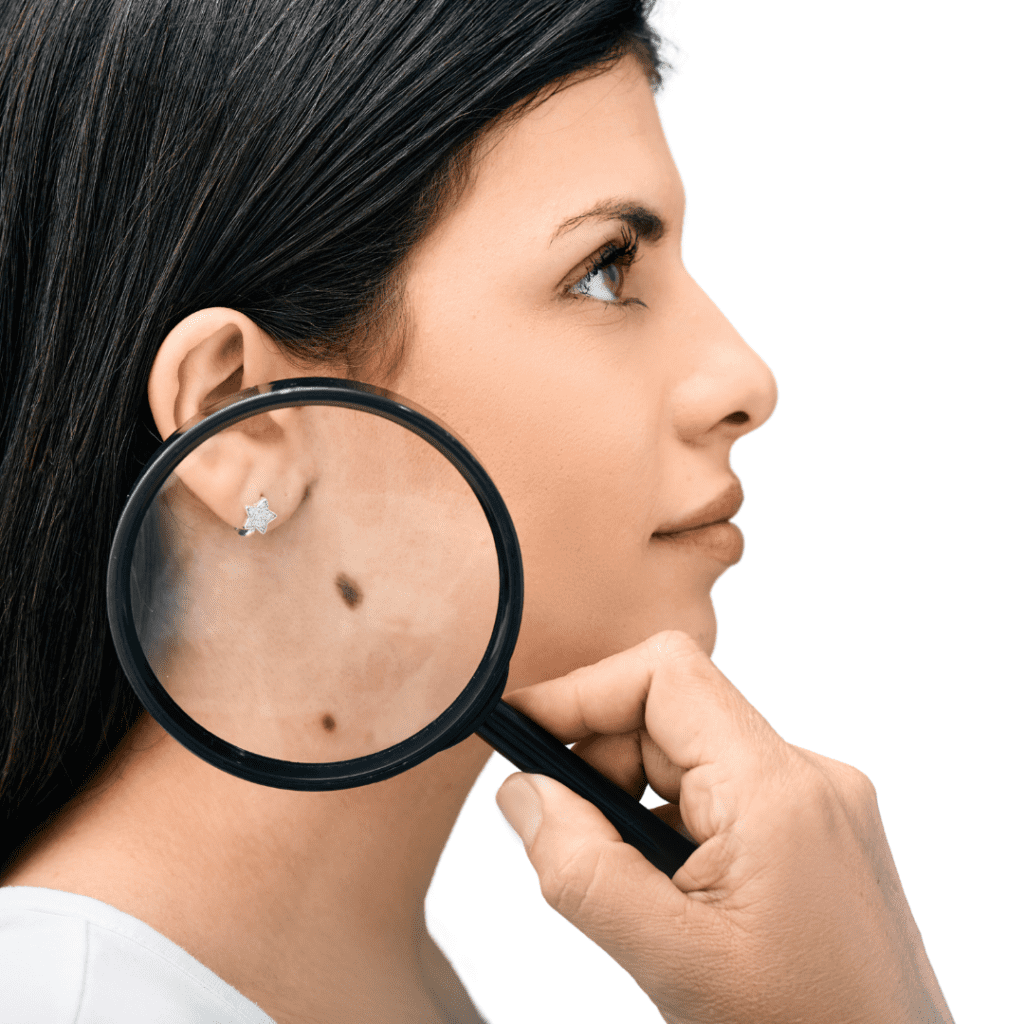


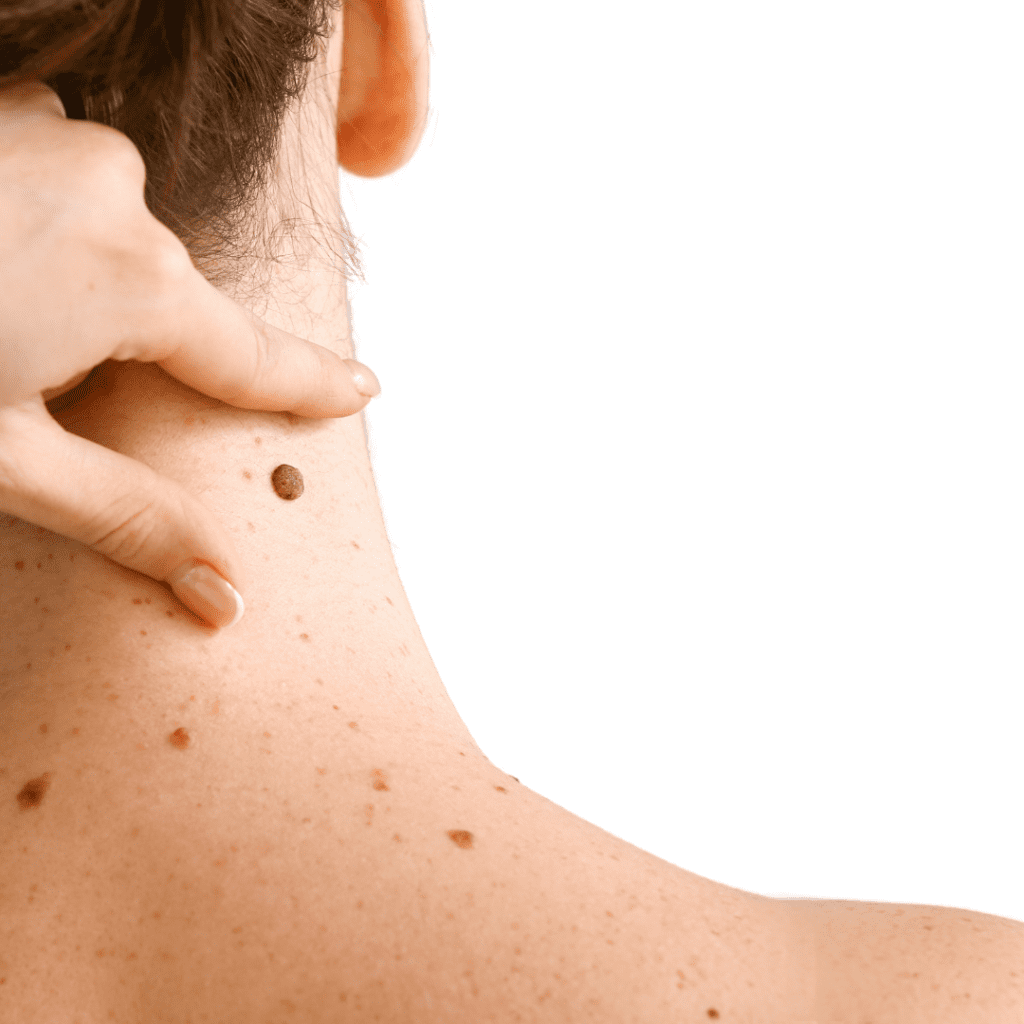
Advanced Mole Removal Treatment in Montreal with Cryotherapy
Are you troubled by a mole in Montreal? Although harmless, these skin lesions can be aesthetically unpleasant, especially if they are located on your face or neck. Our experienced estheticians at Reimagine Clinic utilize the latest and most advanced methods of mole, including the revolutionary Cryoprobe pen for cryotherapy.
What are Moles and Why Should They be Monitored?
A mole is a small skin blemish that can be raised due to a high concentration of melanin, making it darker than the surrounding skin. Moles are quite common, especially in adults with light skin. While most moles are benign (not dangerous), changes in a mole could signal melanoma, a type of skin cancer. This is why it’s crucial to regularly check your skin, particularly if you have numerous moles or a family history of skin cancer.
If one of your moles begins to grow, itch, or bleed, you need to contact a dermatologist or a healt care professional right away. If your mole is benign but noticeable or causing daily irritation—perhaps by interfering with shaving or rubbing against clothing—you may wish to have it removed for aesthetic reasons.
Cryotherapy Mole Removal at Reimagine Clinic
To remove a mole, our estheticians at Reimagine Clinic use cryotherapy, an advanced method that involves the application of extreme cold to the mole using a Cryoprobe pen. This procedure, unlike surgical excision or laser ablation, leaves minimal to no scarring, making it an excellent option for cosmetic mole removal.
The procedure is usually quick, taking less than 10 minutes and can typically be scheduled the same day as your consultation. There’s no pain during the procedure and usually only mild discomfort afterwards.
Book Your Consultation Today
If you’re looking for more information about mole removal at Reimagine Clinic in Montreal, don’t hesitate to contact us. Schedule an informative consultation by calling us at 438-686-8460.
The ABCDEs of malignant mole or melanoma (skin cancer)
The first five letters of the alphabet are a guide to help you recognize the warning signs of melanoma.
A is for Asymmetry. Most melanomas are asymmetrical. If you draw a line through the middle of the lesion, the two halves don’t match, so it looks different from a round to oval and symmetrical common mole.
B is for Border. Melanoma borders tend to be uneven and may have scalloped or notched edges. Common moles tend to have smoother, more even borders.
C is for Color. Multiple colors are a warning sign. While benign moles are usually a single shade of brown, a melanoma may have different shades of brown, tan or black. As it grows, the colors red, white or blue may also appear.
D is for Diameter or Dark. While it’s ideal to detect a melanoma when it is small, it’s a warning sign if a lesion is the size of a pencil eraser (about 6 mm, or ¼ inch in diameter) or larger. Some experts say it is important to look for any lesion, no matter what size, that is darker than others. Rare, amelanotic melanomas are colorless.
E is for Evolving. Any change in size, shape, color or elevation of a spot on your skin, or any new symptom in it, such as bleeding, itching or crusting, may be a warning sign of melanoma.
What should you do if you suspect you’ve accidentally removed a melanoma?
If you remove a skin lesion and then suspect that it might have been a melanoma, you should reach out to a healthcare provider immediately. They may recommend a biopsy of the surrounding tissue to check for remaining cancerous cells, and if necessary, a treatment plan would be established based on the depth and stage of the melanoma.
Remember, if you have any moles or skin changes that are concerning (for example, if they are asymmetrical, have irregular borders, are multiple colors, have a diameter larger than a pencil eraser, or evolve in size, shape, or color), it’s essential to seek medical advice as soon as possible.
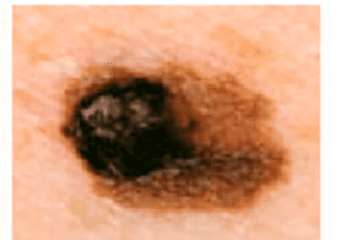
A is for Asymmetry
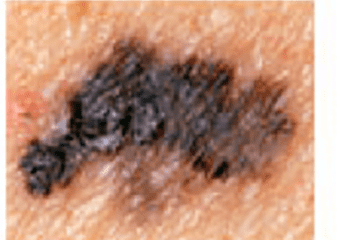
B is for Border
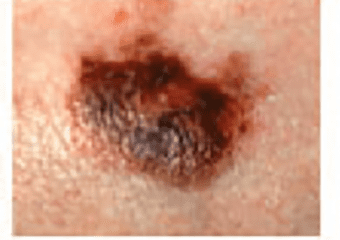
C is for Color
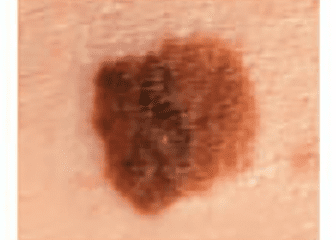
D is for Diameter or Dark
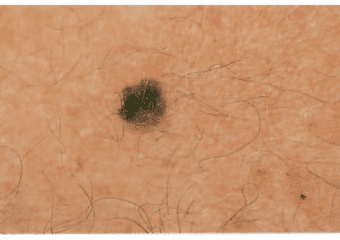
E is for Evolving (Before)
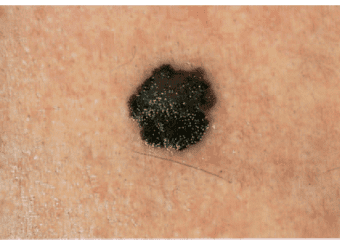
E is for Evolving (After)
Look out for an ugly duckling
The Ugly Duckling is another warning sign of melanoma. This recognition strategy is based on the concept that most normal moles on your body resemble one another, while melanomas stand out like ugly ducklings in comparison. This highlights the importance of not just checking for irregularities, but also comparing any suspicious spot to surrounding moles to determine whether it looks different from its neighbors. These ugly duckling lesions can be larger, smaller, lighter or darker, compared to surrounding moles. Also, isolated lesions without surrounding moles for comparison are considered ugly ducklings.

What can you do?
Check yourself: No matter your risk, examine your skin head-to-toe once a month to identify potential skin cancers early. Take note of existing moles or lesions that grow or change. Learn how to check your skin here.
When in doubt, check it out. Because melanoma can be so dangerous once it advances, follow your instincts. Visit your doctor if you see a spot that just doesn’t seem right.
Keep in mind that while important, monthly self-exams are not enough. See your dermatologist at least once a year for a professional skin exam.
If you’ve had a melanoma, follow up regularly with your doctor once treatment is complete. Stick to the schedule your doctor recommends. This ensures that you identify any recurrence as early as possible.
If you see something NEW, CHANGING or UNUSUAL, get checked by a dermatologist right away. It could be skin cancer. This includes:
- A growth that increases in size and appears pearly, transparent, tan, brown, black, or multicolored.
- A mole, birthmark or brown spot that increases in size, thickness, changes color or texture, or is bigger than a pencil eraser. Learn the ABCDEs of melanoma.
- A spot or sore that continues to itch, hurt, crust, scab or bleed.
- An open sore that does not heal within three weeks.
Perform a self exam!
1. Examine your face
Especially your nose, lips, mouth and ears — front and back. Use one or both mirrors to get a clear view.
2. Inspect your scalp
Thoroughly inspect your scalp, using a blow-dryer and mirror to expose each section to view. Get a friend or family member to help, if you can.
3. Check your hands
Palms and backs, between the fingers and under the fingernails. Continue up the wrists to examine both the front and back of your forearms.
4. Scan your arms
Standing in front of the full-length mirror, begin at the elbows and scan all sides of your upper arms. Don’t forget the underarms.
5. Inspect your torso
Next, focus on the neck, chest and torso. Lift the breasts to view the undersides.
6. Scan your upper back
With your back to the full-length mirror, use the hand mirror to inspect the back of your neck, shoulders, upper back and any part of the back of your upper arms you could not view in step 4.
7. Scan your lower back
Still using both mirrors, scan your lower back, buttocks and backs of both legs.
8. Inspect your legs
Sit down; prop each leg in turn on the other stool or chair. Use the hand mirror to examine the genitals. Check the front and sides of both legs, thigh to shin. Then, finish with ankles and feet, including soles, toes and nails (without polish).
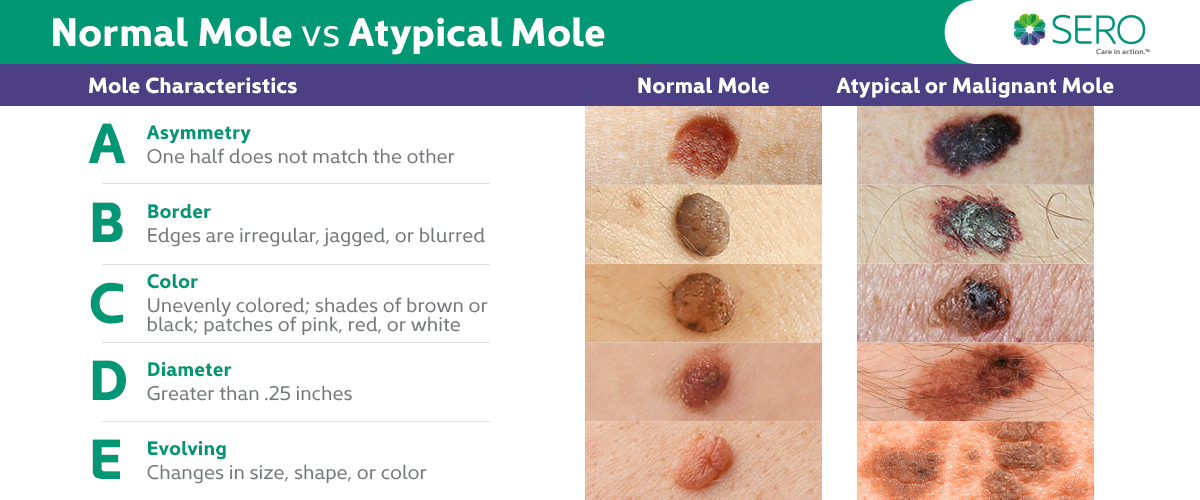
The takeaway
Regular moles are considered ‘normal’ moles. Typically, moles considered normal and benign are symmetrical in shape and have a clearly defined border. Regular moles will also be even in color and not have a diameter exceeding 6mm. In rare cases, regular moles may lack pigment completely.
Mole removal and cosmetic mole treatment can be performed safely on any regular mole. However, if a regular mole has begun to grow or change in appearance, a patient should have a mole examined by a medical professional before planning removal.
Irregular / Atypical Moles
Irregular moles are moles which are not symmetrical in appearance. Moles usually have non-distinct borders. Their thicknesses can and coloration can also vary. In most cases, atypical moles will also be flat, with a diameter exceeding 8mm.
As most people know, atypical moles are the most likely to develop into melanoma. However, it is important to note that not all irregular moles are symptomatic of skin cancer. Atypical moles are representative of a higher risk of skin cancer, and simply need to be monitored for changes in appearance.
Melanoma
what makes us different?
The values we live by
Innovation and Expertise
Reimagine Clinic stands out for its cutting-edge treatments, combining the latest medical advancements with personalized care to ensure the best outcomes for each patient. Their team of highly skilled professionals is dedicated to employing innovative techniques and technologies, providing a unique blend of effective and efficient healthcare solutions. With a strong emphasis on holistic wellness and patient satisfaction, Reimagine Clinic consistently delivers superior treatment experiences that set them apart in the healthcare industry.
Excellence in Patient Care
Our estheticians at Reimagine Clinic in Montreal is renowned for being some of the best in the industry, thanks to her extensive and diverse training. They are a triple-certified professional, holding qualifications as an Esthetician, Advanced Esthetician, and Medical Esthetician, showcasing their wide-ranging expertise in skincare and beauty treatments. Their commitment to continuous learning and mastery in various esthetic disciplines makes them exceptionally skilled in providing personalized, top-tier care to every client.
Integrity and Transparency
We offers a diverse array of treatments to cater to various beauty and medical needs. Our services include a range of facials, from classic care to specialized treatments like chemical peels, and advanced procedures for skin lesions. For those seeking cutting-edge solutions, we provide state-of-the-art laser treatments, along with expertly applied permanent makeup. Our body treatments are designed for relaxation and rejuvenation, while our lash and brow services ensure the perfect finishing touches to your look.
we’re here to answer all your questions
A Cryoprobe pen (Health Canada approved) is an advanced instrument used in cryotherapy procedures. It precisely applies extreme cold to a specific area, such as a mole, to freeze and destroy the unwanted tissue without damaging the surrounding skin.
In cryotherapy, the Cryoprobe pen is used to freeze the mole, causing the cells within the mole to crystallize and die. Over time, the treated mole falls off, leaving the skin clear.
The mole removal process using cryotherapy is typically not painful. Some patients may experience a slight stinging sensation when the cold is applied, but this is usually brief.
Cryotherapy is generally safe. However, like any procedure, there can be potential risks such as skin irritation, discoloration, and rarely, scarring. It is important to discuss these potential risks with your esthetician before the procedure.
Before any mole removal, it’s crucial to have the mole evaluated by a healthcare professional to ensure it is not malignant (cancerous). If there are any suspicions, a biopsy may be performed. In case the mole is found to be malignant, a different course of treatment will be advised.
The treated mole usually starts to scab over a few days after cryotherapy and falls off within one to two weeks. The timing can vary depending on the size and location of the mole.
After cryotherapy, it is important to keep the treated area clean and dry. You should avoid picking at or scratching the area. Direct sun exposure should be avoided and sunscreen should be applied regularly. Your esthetician will provide you with detailed aftercare instructions.
Yes, cryotherapy can be used to treat multiple moles in a single session. It’s a quick procedure, typically taking less than 10 minutes per mole, making it possible to treat several moles in one visit.
Scheduling a consultation at Reimagine Clinic is easy. You can call us at 438-686-8460 to book an appointment. We look forward to assisting you with your mole removal and cryotherapy needs in Montreal.
Drop us your questions
If you have questions? Let us know and we will get back to you as soon as we can
Email Us
info@reimagineclinic.ca
Call Us
438-686-8460